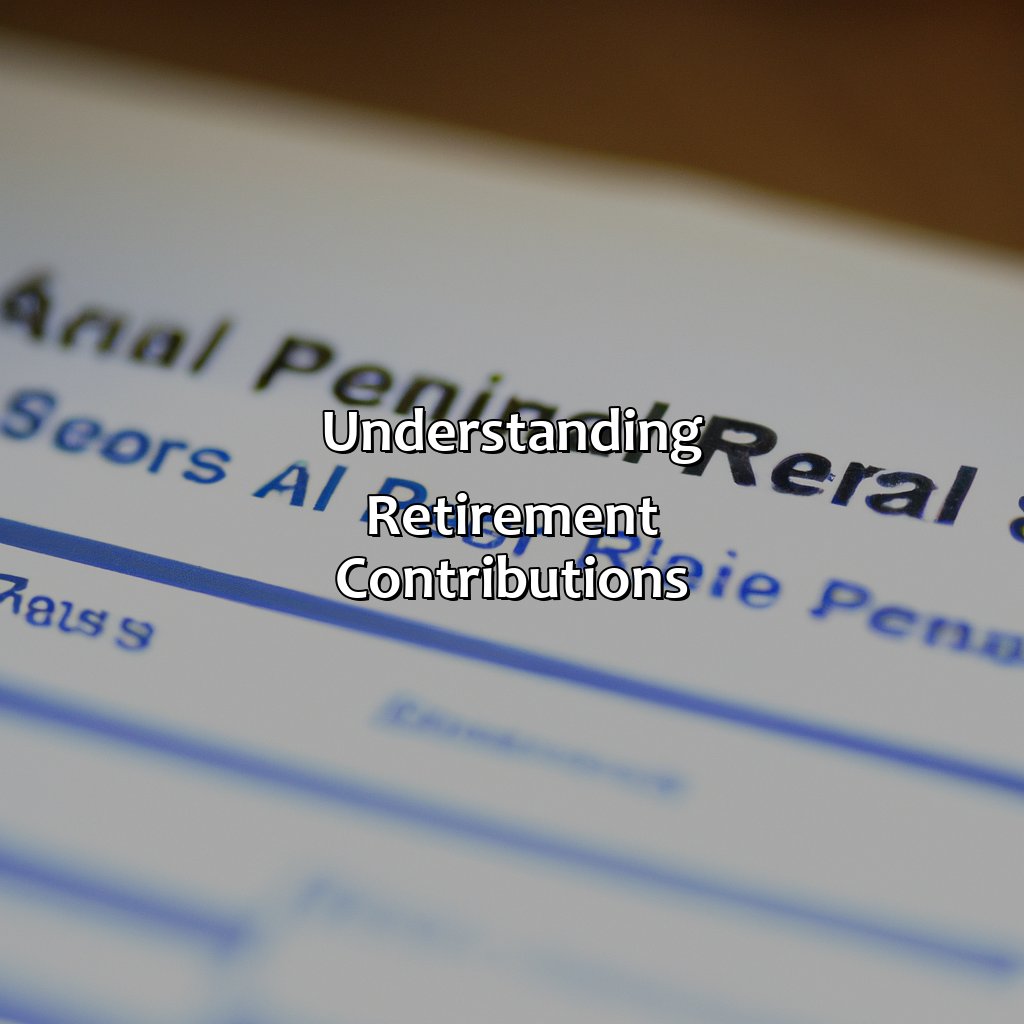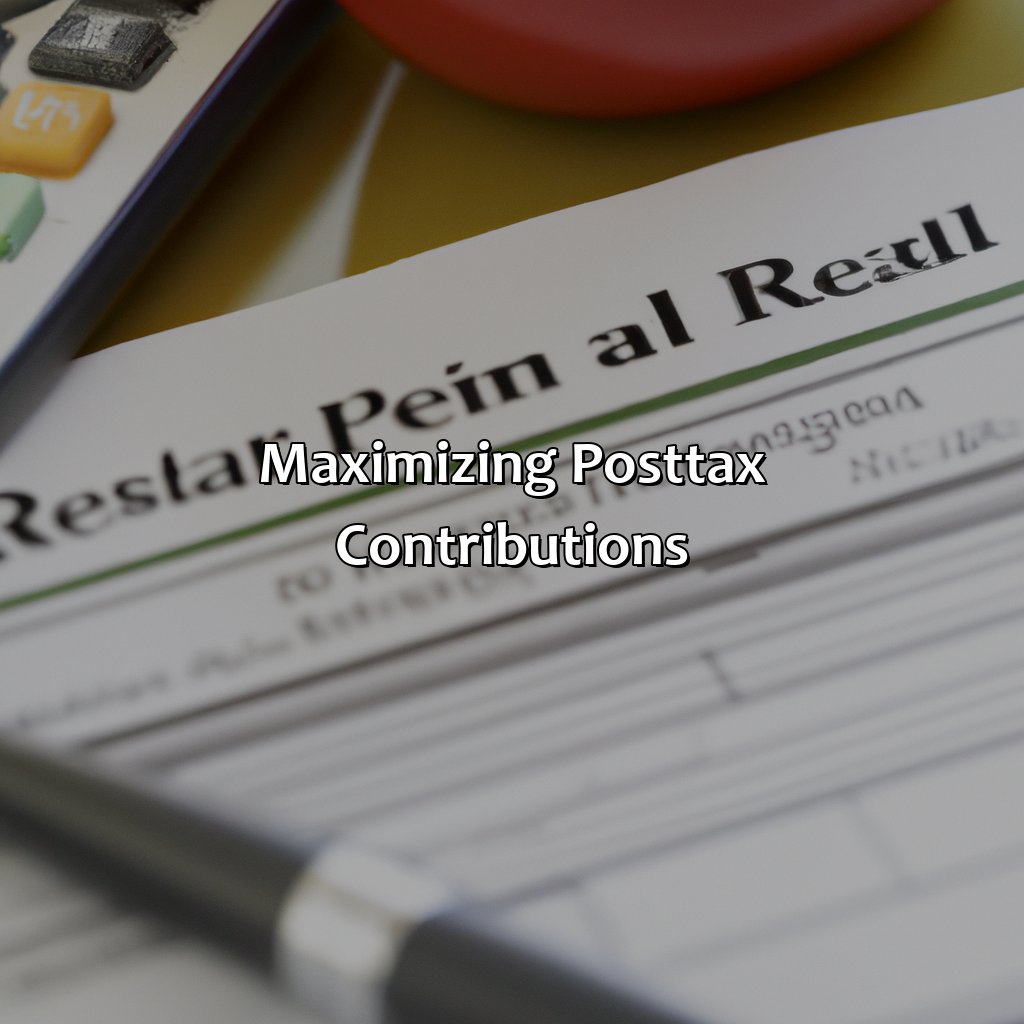How To Maximize Retirement Contributions?
Key takeaways:
- Understanding Retirement Contributions: To maximize retirement contributions, it’s essential to understand the various contribution types, including pre-tax and post-tax contributions, and investment options such as 401(k), 403(b), and IRA.
- Maximizing Pre-Tax Contributions: Consider increasing contributions to 401(k) or 403(b) plans, utilizing catch-up contributions if you’re over 50, and taking advantage of employer matching programs.
- Maximizing Post-Tax Contributions: Open a Roth IRA account to make post-tax contributions, make non-deductible traditional IRA contributions if Roth IRA is not an option, and consider other investment options like real estate or taxable accounts. Seek professional advice and guidance to make informed decisions.
Are you looking to grow your retirement savings? Maximizing your retirement contributions is a great way to ensure financial security in the future. Learn how to create a plan to maximize your retirement contributions and take control of your financial future.
Understanding Retirement Contributions
Retirement Contributions: Maximizing Your Savings
When planning for retirement, understanding retirement contributions becomes crucial. Maximizing your contributions allows you to save efficiently and make the most of your retirement fund. To achieve this, it’s important to understand the different types of contributions and contribution limits.
Employer-sponsored retirement plans, such as 401(k) and 403(b), allow employees to contribute pre-tax dollars, which lowers taxable income and increases overall savings. Additionally, individuals can contribute to traditional or Roth IRA accounts on their own. Traditionally, IRA contributions are made with pre-tax dollars, while Roth IRA contributions are made with after-tax dollars.
To ensure maximum contributions, it’s crucial to take advantage of employer-sponsored plans and understand contribution limits. For 2021, the annual contribution limit for 401(k) and 403(b) plans is $19,500. The annual contribution limit for traditional and Roth IRA accounts is $6,000. Individuals over the age of 50 can make additional catch-up contributions, with an annual limit of $1,000 for IRAs and $6,500 for 401(k) and 403(b) plans.
A study conducted in 2020 found that nearly 30% of individuals aged 55 and older had no retirement savings. This highlights the importance of maximizing contributions and starting early. By maximizing contributions and understanding retirement plans and limits, individuals can ensure a secure and stable future in retirement.

Image credits: retiregenz.com by Yuval Duncun
Maximizing Pre-Tax Contributions
Maximize pre-tax contributions! Increase 401(k) or 403(b) contributions. Utilize catch-up contributions! Reap the benefits of employer matching. Get planning and investing early for maximum retirement savings. It’s worth it!

Image credits: retiregenz.com by Adam Duncun
Increasing 401(k) or 403(b) Contributions
To increase the amount of money you save for your retirement, it’s important to explore ways to augment your contributions to your 401(k) or 403(b) plans. Here are some steps you can follow to boost your savings:
- Figure out how much you can contribute – If you’re 50 or older, you might be able to make additional catch-up contributions. Check with your employer about their contribution limits.
- Review automatic contribution deductions – You could increase the percentage of your salary that’s automatically deducted each pay period.
- Allocate bonuses and pay raises – Consider channeling all or some of these unexpected funds towards retirement savings.
- Increase contributions when possible – Aim for steady increases in the amount you save and try to divert more funds when you reach certain financial milestones.
- Consider removing limitations on salary deferrals – It might be worthwhile moving from basic salary deferral programs where higher-level positions don’t have any deferral limitations, so check out any potential upgrades that fit with the rules of your plan.
Contribute the maximum amount authorized under law for an optimal outcome as social security pensions may not be sufficient. REMEMBER! The younger you start saving, the better, so rule out procrastinating even if it seems easier at present.
Lastly, take swift action now before losing out on potential funds that could accrue over time. Start increasing retirement contributions today and enjoy significant benefits in the future while avoiding feelings of stress caused by falling short of expected savings goals.
Getting old may not be fun, but catching up on retirement contributions definitely is.
Utilizing Catch-Up Contributions
Making the most of Pre-Tax Contributions involves exploring various options to contribute as much as possible towards retirement funds. One way to do so is by utilizing the opportunity to make Catch-Up Contributions, which are additional contributions beyond taxpayer limits allowed for those who are 50 years or older.
These catch-up contributions can amount up to $6,500 annually for those who qualify, and this extra amount can prove significant in maximizing retirement funds. By taking advantage of this tax-deferred savings option, individuals can better prepare themselves financially for their post-retirement years.
Additionally, it’s crucial to note that Catch-Up Contributions can only be made after reaching the regular contribution limit set by the IRS. Therefore, it’s essential first to maximize available contribution amounts before considering catch-up contributions.
To make sure you are making full use of Catch-Up Contributions, consult with a financial advisor who will help you evaluate your financial situation and determine what options make sense for your individual circumstances. Your advisor may suggest strategies such as reallocating budgeted expenses toward retirement accounts or post-tax contributions to optimize your pre-tax contributions. With careful planning and expert advice, you can effectively manage your finances and achieve your retirement goals.
If your employer offers matching contributions, take it as a sign that they want you to retire one day and not haunt the office as a ghost.
Taking Advantage of Employer Matching
To Boost Your Retirement Savings: Utilizing Employer Matching Contributions
Employer matching contributions can help you maximize your retirement benefits. Here are some ways to take advantage of this opportunity:
- Find out about the employer’s match policy
- Try to contribute as much as possible to receive the full match amount
- If possible, front-load annual 401(k) contributions to reach maximum limit before the end of the year
- Consider investing in low-cost index funds or other diversified options available in the retirement plan
- Check whether there’s vesting schedule attached with matching contributions and make choices accordingly
- Routinely review your account to ensure you are on track for meeting your savings goals
It is also important to remember that employer match is just one part of a comprehensive saving strategy, and examining other tax-advantaged plans such as IRAs or HSA accounts can help diversify savings.
Don’t miss out on maximizing your retirement savings by ignoring employer matches. Take advantage of these opportunities and make sure you are contributing enough to secure the full benefit. Planning ahead with all available information can give peace of mind come retirement.
Who needs a safety net when you can just put all your money into retirement savings and live off of hope and dreams?
Maximizing Post-Tax Contributions
Maximize your retirement contributions for post-tax investments? Check out the options! Choose between a Roth IRA or non-deductible traditional IRA. Both have their perks. This section will explore them in depth. Make an informed decision for your post-tax investments.

Image credits: retiregenz.com by Adam Duncun
Opening a Roth IRA
The process of initiating a Roth IRA can be perplexing. Here’s how to get started:
- Verify your eligibility
- Determine the amount you want to contribute
- Choose your service provider
- Fill in the application forms
- Submit the required documentation and funding sources
- Allocate funds to specific investments after account activation
It is essential to note that contributions are usually after-tax money. However, they grow tax-free when invested, and withdrawals made after reaching retirement age are not taxed.
When you open a Roth IRA, there are particular details that you need to include in your application. Your name, address, birth date, social security number or tax identification number, financial services company information are necessary.
Surprisingly, according to IRS statistics, less than half of people under 70 years have invested in an IRA. It’s critical to note that opening a Roth IRA is an ideal method to plan for a financially stable future.
Saving for retirement? More like saving for the inevitable disappointment that is old age.
Making Non-Deductible Traditional IRA Contributions
One effective way to maximize retirement contributions is by making non-deductible contributions to a traditional IRA. This allows individuals to contribute after-tax funds, which can then grow tax-free until withdrawal in retirement. It is important to note that these contributions must be reported on IRS form 8606 to avoid double taxation upon withdrawal.
By making non-deductible contributions, individuals can ultimately increase their overall contributions and potentially lower their taxable income in retirement. Additionally, those who are not eligible for a Roth IRA may find this option beneficial.
It is important to carefully weigh the pros and cons of non-deductible traditional IRA contributions before making them. Some factors to consider include the individual’s tax bracket, expected future tax rates, and the potential impact on eligibility for other retirement accounts.
A financial advisor can provide personalized guidance on whether non-deductible traditional IRA contributions align with an individual’s overall financial goals and retirement strategy.
A colleague of mine decided to make non-deductible traditional IRA contributions as part of his overall retirement planning. By doing so, he was able to maximize his contributions and take advantage of tax-free growth while maintaining eligibility for other retirement accounts. This decision ultimately supported his long-term financial goals and allowed him greater flexibility in retirement.
Remember, if investing in the stock market makes you nervous, you can always try burying your money in the backyard – just make sure to mark the spot.
Considering Other Investment Options
Maximize your retirement contributions! Investing in Real Estate, opting for Taxable Accounts, and seeking Professional Advice and Guidance can help you out. Each option has its own unique benefits. They can help diversify your investment portfolio and raise your retirement savings!

Image credits: retiregenz.com by Harry Woodhock
Investing in Real Estate
Real estate investments, an excellent alternative in diversifying retirement funds, can assist in building equity and augmenting passive income for a stress-free future.
By participating in real estate ventures like rental properties or real estate investment trusts (REITs), investors are permitted to generate returns through rents or equity growth. The distinguished significant advantage of real estate is the opportunity to deduct mortgage interest and depreciation against the collected revenue, creating favorable tax circumstances.
It is crucial to note that investing in properties involves risks such as interest rates fluctuations, difficulty selling assets at the right time, and property management hurdles.
To ensure success when investing in real estate, focus on deep market research and due diligence before making any substantial decisions that could impact your finances.
Don’t miss out on your chance to experience financial stability during retirement by capitalizing on lucrative real estate investment opportunities.
Who needs tax breaks when you can just pay more taxes? Opt for taxable accounts, live a little.
Opting for Taxable Accounts
When it comes to diversifying retirement investments, one may consider utilizing taxable accounts. These accounts allow investors to purchase assets that generate taxable returns but offer more flexibility than traditional tax-advantaged retirement accounts. In addition, taxable accounts can serve as a reliable source of income during market downturns.
Investors should be mindful of managing taxes associated with these accounts. Capital gains from sales and dividends earned are subject to taxes, and annual tax planning should be considered. However, taxable investments may act as a compliment to pre-tax contributions if allocated wisely.
It is important to note that while taxable accounts hold different tax implications in comparison to retirement plan contributions such as 401(k)s or IRAs, they do not provide the same tax benefits. Nevertheless, they can make up an essential component for those seeking diversified investment strategies.
According to MarketWatch, “Roughly one-third of high-net-worth clients have more than 60% of their portfolios invested in taxable accounts“.
Seeking Professional Advice and Guidance
Seeking Expert Advice for Retirement Planning: Invest Optimally for a Brighter Future!
Getting assistance from a Financial Advisor and Counselor is essential to ensure effective retirement planning. A professional’s knowledge can help maximize investments, understand market trends, and minimize risks to gain better returns.
An expert will thoroughly assess an individual’s financial standing, goals, risk appetite, and investment experience to provide personalized advice and guidance. They also assist in managing portfolios, tracking investment performance, and suggesting periodic evaluations.
Seeking Expert Advice reduces possible errors in investment decision-making by providing insights into diversified product options beyond traditional plans. With a Professional’s help, one can plan for retirement with greater diversity across assets generating suitable ROI naturally.
Explore various product offerings like equity securities or fixed-income instruments backed by potentially tax-free vehicles like Roth IRA or annuities as an alternative option instead of sticking only with 401(k) matching contributions.
Remember that retirement savings are long-term investments that require consistent monitoring and optimization through every stage of life. Hence seeking assistance from professional counselors seems highly necessary for investing optimally throughout their career cycle. Take a step today to secure your bright future tomorrow!
Five Facts About How To Maximize Retirement Contributions:
- ✅ The 2021 contribution limit for 401(k) plans is $19,500, plus an additional $6,500 for those over age 50. (Source: IRS)
- ✅ The contribution limit for traditional and Roth IRAs in 2021 is $6,000, plus an additional $1,000 for those over age 50. (Source: IRS)
- ✅ Many employers offer a matching contribution to their employees’ 401(k) plans, which is essentially free money for retirement savings. (Source: Investopedia)
- ✅ Catch-up contributions, allowed for those who are age 50 or older, can help boost retirement savings for those who may have started saving later in life. (Source: Fidelity)
- ✅ Automated contributions, like increasing your 401(k) contribution rate annually, can help increase retirement savings without requiring much effort. (Source: CNBC)
FAQs about How To Maximize Retirement Contributions?
1) How can I maximize my retirement contributions?
To maximize your retirement contributions, consider contributing the maximum amount allowed by your employer-sponsored retirement plan, such as a 401(k) or 403(b). You should also consider opening an individual retirement account (IRA) and contributing the maximum amount allowed annually. Additionally, you may want to consider making catch-up contributions if you are over the age of 50.
2) What are catch-up contributions?
Catch-up contributions allow individuals age 50 and older to contribute additional funds to their retirement accounts above the annual contribution limit. For example, in 2021, individuals can make catch-up contributions of up to $6,500 to a 401(k) plan and up to $1,000 to an IRA.
3) Can I make retirement contributions even if I don’t have a traditional employer-sponsored retirement plan?
Yes, you can still make retirement contributions even if you do not have access to an employer-sponsored plan. Consider opening an individual retirement account (IRA) and contributing up to the maximum amount allowed annually. If you are self-employed, you may also consider a SEP-IRA or a Solo 401(k).
4) Are there income limits for making retirement contributions?
Yes, there are income limits for making retirement contributions. For example, in 2021, individuals with a modified adjusted gross income (MAGI) over $140,000 (or $208,000 for married couples filing jointly) may not be eligible to contribute the full amount to a Roth IRA. It is important to consult with a financial advisor to determine your specific eligibility.
5) What are the benefits of maximizing my retirement contributions?
Maximizing your retirement contributions can help you to build a strong retirement portfolio and provide for a comfortable retirement. Additionally, contributing to retirement accounts can provide tax benefits, as contributions to traditional retirement accounts may be tax-deductible and earnings grow tax-free until withdrawn.
6) Can I make changes to my retirement contributions throughout the year?
Generally, you can make changes to your retirement contributions throughout the year, typically through your employer-sponsored retirement plan or by contacting your financial institution. It is important to note that there may be specific restrictions or limitations on making changes to retirement contributions, so it is important to consult with your financial advisor or plan administrator.




